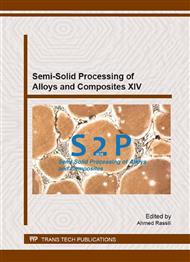[1]
J.R. Davis, Corrosion of Aluminum and Aluminum Alloys, ASM International, Materials Park, (1999).
Google Scholar
[2]
S. Vaidya and C.M. Preece, Cavitation Erosion of Age-Hardenable Aluminum Alloys, Metall. Trans. A. 9 (1978) 299-307.
DOI: 10.1007/bf02646379
Google Scholar
[3]
B. Dybowski, B., Szala, M., Kiełbus, T. Hejwowski, Microstructural phenomena occurring during early stages of cavitation erosion of Al-Si aluminium casting alloys, Solid State Phenom. 227 (2015) 255-258.
DOI: 10.4028/www.scientific.net/ssp.227.255
Google Scholar
[4]
W.J. Tomlinson, S.J. Matthews, Cavitation erosion of aluminium alloys, J. of Mater. Sci. 29- 4 (1994) 1101-1108.
Google Scholar
[5]
B.C.S. Rao, D.H. Buckley, Erosion of aluminum 6061-T6 under cavitation attack in mineral oil and water, Wear 105-2 (1985) 171-182.
DOI: 10.1016/0043-1648(85)90023-7
Google Scholar
[6]
X.Y. Lia, Y.G. Yan, L. Ma, Z.M. Xu, J.G. Li, Cavitation erosion and corrosion behavior of copper-manganese-aluminum alloy weldment, Mat. Sci. Eng. A - Struct. 382-1-2 (2004) 82-89.
DOI: 10.1016/j.msea.2004.04.032
Google Scholar
[7]
H.G. Feller, Y. Kharrazi, Cavitation erosion of metals and alloys, Wear 93- 3 (1984) 249-260.
DOI: 10.1016/0043-1648(84)90199-6
Google Scholar
[8]
A. Karimi, J.L. Martin, Cavitation Erosion of Materials. Int. Met. Rev. 31-1 (1986) 1-26.
Google Scholar
[9]
M. Mlkvik, R. Olšiak, B. Knížat J. Jedelský, Character of the cavitation erosion on selected metallic materials, EPJ Web of Conf. 67, 02076 (2014).
DOI: 10.1051/epjconf/20146702076
Google Scholar
[10]
M.C. Flemings, R.A., Martinez, Principles of microstructural formation in semi-solid metal processing. Solid State Phenom. 116-117 (2006) 1-8.
DOI: 10.4028/www.scientific.net/ssp.116-117.1
Google Scholar
[11]
A. Pola, L. Montesano, M. Gelfi, R. Roberti, Fracture toughness and corrosion resistance of semisolid AlSi5 alloy, AIP Conference Proceedings 1353- 1 (2011) 1051-1056.
DOI: 10.1063/1.3589655
Google Scholar
[12]
K.B. Nie, X.J. Wang, K. Wu, L. Xu, M.Y. Zheng, X.S. Hu, Processing, microstructure and mechanical properties of magnesium matrix nanocomposites fabricated by semisolid stirring assisted ultrasonic vibration, J. Alloy Compd 509-35 (2011, 8664–8669.
DOI: 10.1016/j.jallcom.2011.06.091
Google Scholar
[13]
A. Arrighini, M. Gelfi, A. Pola and R. Roberti, Effect of ultrasound treatment of AlSi5 liquid alloy on corrosion resistance, Materials and Corrosion 61-3 (2010) 218-221.
DOI: 10.1002/maco.200905303
Google Scholar
[14]
G. Gottardi, A. Pola, G.M. La Vecchia, Solid fraction determination via DSC analysis, Metall. Ital. 5 (2015) 11-16.
Google Scholar
[15]
A. Pola, A. Arrighini, R. Roberti, Effect of ultrasounds treatment on alloys for semisolid application, Solid State Phenom. 141-143 (2006) 481-486.
DOI: 10.4028/www.scientific.net/ssp.141-143.481
Google Scholar
[16]
G. I. Eskin, D. G. Eskin, Ultrasonic Treatment of Light Alloy Melts, Taylor & Francis Group, NW, (2014).
DOI: 10.1201/b17270
Google Scholar
[17]
AFNOR NF A04-503: 1988 Semi-products made from aluminium, copper, nickel and their alloys. Determination of grain size. Aluminium and aluminium alloys.
Google Scholar
[18]
ASTM G 32 standard. Standard Test Method for Cavitation Erosion Using Vibratory Apparatus.
Google Scholar
[19]
S. Chayong, H.V. Atkinson, P. Kapranos, Thixoforming 7075 aluminium alloys, Mat. Sci. Eng. A-Struct 390-1-2 (2005) 3-12.
DOI: 10.1016/j.msea.2004.05.004
Google Scholar
[20]
A. Pola, L. Montesano, M. Gelfi, R. Roberti, Semisolid processing of Al-Sn-Cu alloys for bearing applications. Solid State Phenom, 192-193 (2012) 56.
DOI: 10.4028/www.scientific.net/ssp.192-193.562
Google Scholar
[21]
A. Pola, M. Gelfi, M. Modigell, R. Roberti, Semisolid lead-antimony alloys for cars batteries. T. Nonferr. Metal. Soc. 20-9 (2010) 1774-1779.
DOI: 10.1016/s1003-6326(09)60373-3
Google Scholar


